Table of contents
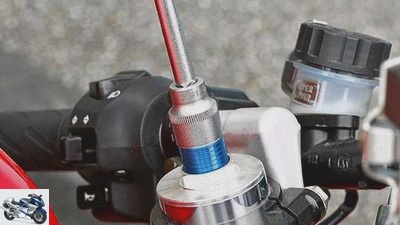
accesories
landing gear & Spring elements
This is how it works: Adjust the spring base yourself
This is how it works: Adjust the spring base
Adjust the spring base yourself
How do I set up my chassis correctly? Motorcycle chassis often offer a variety of adjustment options. Before the experiments with the damping adjustment, the spring base must be correct. 2Rader shows how it’s done.
Manuel Fuchs
04/24/2012
The right spring base
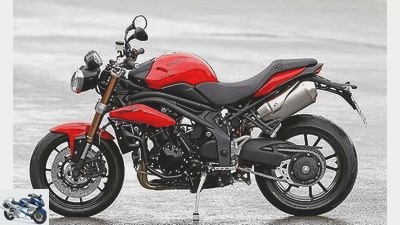
Triumph Speed Triple.
“How do I properly tune my suspension??” Before you dive into the depths of rebound and compression damping, make sure you have the right spring base. The rule of thumb is:
When stationary, a motorcycle without a driver sinks in front by a quarter of the total suspension travel and in the rear by a tenth. With the rider, the motorcycle should deflect by a third at the front and a quarter at the rear. How do you do that?
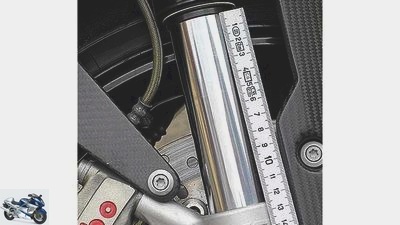
Fasten the cable tie to the immersion tube, rebound completely and note the measured value.
First step:
Rebound the motorcycle so far that the front wheel is no longer in contact with the ground.
If the main stand or front jack is not available, a second person can tip the motorcycle over the side stand.
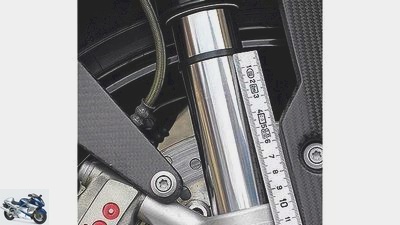
Park the motorcycle without a rider, measure the distance from the cable tie to the fork base.
Second step:
Measure the visible length of the fork inner tube (with conventional forks on the handlebar, with upside-down forks on the bike).
This is the total spring deflection G. Tighten the cable tie around the inner tube and push it against the outer tube.
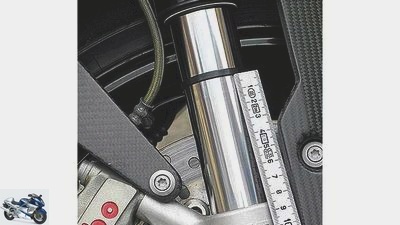
Load the motorcycle with the rider, measure the distance from the cable tie to the fork base.
Third step:
Park the motorcycle, measure the distance from the cable tie to the end of the spring travel.
The difference between this value and the total spring travel G is the unloaded, static negative spring travel N1.
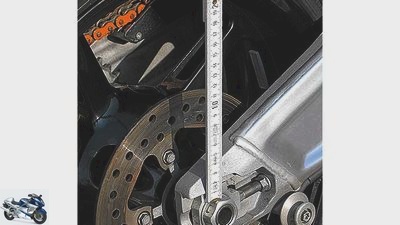
Same process as at the front, measured with fixed points on the rear frame and rear axle.
Fourth step:
Driver sits up. Measure the distance from the cable tie to the end of the spring travel again. The difference to G is the loaded, static negative spring deflection (N2). Determining the total travel of the rear wheel is a little more complicated.
The value from the manual can be used as an approximation; 120 to 130 mm are common for street motorcycles. To determine N1 and N2, mark a point on the rear of the motorcycle and measure from there to the wheel axle.
On the fork, the spring base is adjusted using threaded spindles at the upper end of the two bars, on the spring strut either conveniently using a hydraulic system with a rotary knob, or a little less comfortably using a hook wrench (see right).
Gradually approach the target values mentioned at the beginning and check after every change on a known route whether the handling of your motorcycle has improved and whether you are still feeling well. If you have to increase the spring base for a correct N2 so that N1 becomes zero, the spring is too soft. Then the only way to help is to see a specialist who swaps the springs or the entire shock absorber – or you can come to terms with a compromise.
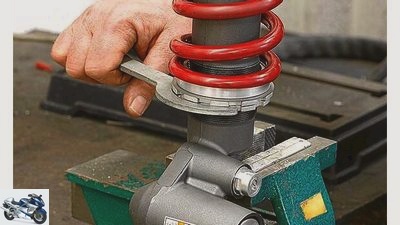
In the worst case, spring struts that are difficult to access must be removed in order to change the preload. Rule of thumb: 10 mm change at the rear corresponds to 3 to 5 mm at the shock absorber.
Heavy riders or riders who often ride with a pillion can set the N2 value about 5 mm lower, i.e. turn the spring base a little higher. Very light riders set 5 mm more negative suspension travel. Anyone who exhausts the tolerance range also influences the handling of their motorcycle: A higher spring base (i.e. less static negative spring travel) on the fork and shock absorber tends to make it more manageable, a deeper spring base makes it more stable.
Compression damping
The compression damping brakes the compression. The tighter it is set, the stronger the braking effect.
Spring base
The spring base, too “preload” called, determines the ratio of positive and negative spring deflection.
Spring stiffness
The property of a spring is given in Newton / mm, occasionally also in kg / cm: This is the amount of force required to compress the spring by the relevant amount.
High / low speed damping
Allows separate adjustment for fast and slow spring movements; has nothing to do with the speed being driven, but with the speed of the damper piston.
Negative travel
Available for rebound; changes depending on the driving situation.
Positive suspension travel
Is available for compression, changes depending on the driving situation.
Progression / Progressive
A chassis that opposes the compression movement with increasing resistance works progressively. Can be implemented using appropriate springs, a deflection or path-dependent damping.
Rebound damping
Brakes the rebound. If it is too strong, the motorcycle will remain compressed for too long and can no longer dampen the next wave. If it is too weak, the motorcycle rebounds too quickly and becomes restless.
Related articles
-
Two-cylinder special: base against noble
motorcycles Two-cylinder special: base against noble Two-cylinder special: base against noble For a handful of dollars more Content of Sure, you can buy…
-
Suspension guide – correctly adjusting the damping, part 1
Photos: fact accesories landing gear & Spring elements Adjusting suspension / damping correctly, part 1 Guide: Adjusting the suspension / damping…
-
accesories landing gear & Spring elements Basic chassis set-up Basic chassis set-up Basic chassis set-up The chassis tuning begins with the inspection of…
-
Introduction of chassis tuning
fact 12th pictures Edge 1/12 The strut sits on the right outside of the chassis without any deflection. In the limited edition an Ohlins TTX36. Cook 2/12…
-
This is how a tempo control works
Bilski counselor traffic & business This is how a tempo control works This is how a tempo control works What if it flashes red? Then comes a ladle or…
-
This is how it works: Replace the seat
Bilski counselor workshop This is how it works: Replace the seat That’s how it’s done Renew the seat Come on: shift your frustration to your old bank….
-
This is how it works: motorcycle care
accesories This is how it works: motorcycle care This is how it works: motorcycle care With these tips, your motorcycle will sparkle again as if it were…
-
This is how it works: Remove rust from the tank
counselor workshop This is how it works: Remove rust from the tank This is how it works: derust the tank How do I get rid of the rust? Rotten fuel…
-
Balancing motorcycle tires – this is how it works
wolf 8th pictures wolf 1/8 Haweka balancing professional Uwe Westermann at the versatile Bike Boss Louis 2/8 Static yes, dynamic no: balancing stands…
-
Advice: adjust springs and dampers
Schermer counselor workshop Advice: adjust springs and dampers Advice: adjust springs and dampers Tips for adjusting the suspension and damping On modern…